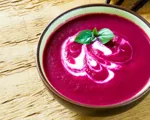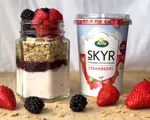
Quark and skyr are good and versatile dairy-based products that can be used for various things in the kitchen, for example, sauces, dressings, and baked goods. Quark has its origins in Germany, while skyr originates from Iceland, but both have seen a rise in popularity over the years and have stepped onto the worldwide stage.
In the following, we look at some of the differences between the two in terms of contents and how they are used. If you are interested in more comparisons, you can also read about skyr vs kefir and skyr vs Greek yogurt. Or get a complete overview of yogurt-like products in our article about different types of yogurt.
What is the difference between quark and skyr?
The main difference between quark and skyr lies in their texture and taste. While both are dairy-based products, the differences in the production process result in two different flavour profiles and two different textures. However, since neither 'skyr' nor 'quark' are protected titles (outside Iceland in the case of the former), resulting in fixed production methods, it can be hard to say exactly what distinguishes the two products, as they can be produced in different ways.
Quark
Quark is typically made by adding lactic acid bacteria to high-pasteurised skimmed cow's milk. This acidifies the milk and gives quark its tangy flavour. Afterwards, it is strained, and the whey is removed through draining. The result is firm, creamy quark with high dry matter.
Skyr
Skyr also usually uses bacterial cultures in its fermentation process, albeit different ones. These cultures are added after the milk (typically skimmed cow's milk) is pasteurised and has cooled down. After the fermentation, the liquid whey is drained and a delicious skyr has been made. It has less dry matter than quark.
Quark has a mild and slightly tangy flavour. With its firm, smooth, and creamy texture, it is similar to cream cheese or thick yogurt. Skyr has a wonderfully thick but slightly less firm consistency like the one you maybe know from Greek-style yogurt. So, although they do share some similarities, quark and skyr are two different products derived from different production methods. The main differences between the two are the bacterial cultures used to sour the milk and the level of dry matter in the final product.

Is the protein content the same in skyr and quark?
In general, skyr and quark have more or less the same protein content. It may vary depending on the specific product, but both usually contains about 9-12 grams of protein per 100 grams. This gives a protein energy contribution of about 59-71.5%, meaning that both skyr and quark are considered high protein products. The criterion for gaining this accolade is that at least 20% of the energy value of the food must be provided by protein. To be considered a source of protein, the criterion is 12%.
Can I use skyr instead of quark?
Yes, it may cause a change in texture and flavour of the final dish, but in many quark recipes, it is possible to substitute quark with skyr. This is because they have a similar consistency, and their flavours are not too far from each other. Note that skyr has a slightly drier flavour so you may want to add a touch of lemon or a mild sweetener to better mimic the quark if you choose to make the substitution. Or you can check out our Skyr recipes.




































&format=webp)







